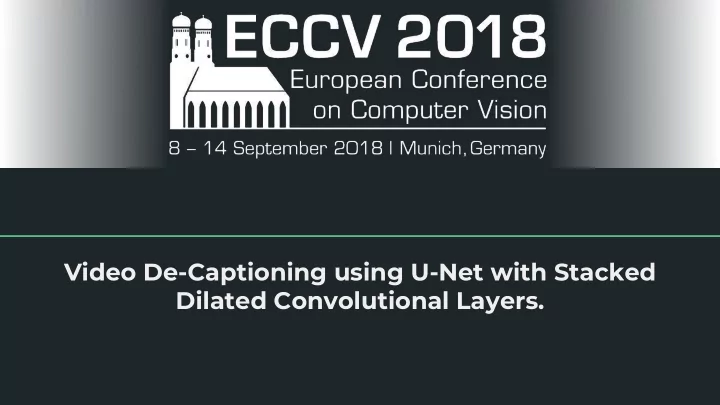

Video De-Captioning using U-Net with Stacked Dilated Convolutional Layers.
ChaLearn Video Decaptioning Video Decaptioning using U-Net with Challenge Stacked Dilated Convolutional Layers Team : Shivansh Mundra Mehul Kumar Nirala Sayan Sinha Arnav Kumar Jain
Who are we? Well, we are a bunch of undergraduates from India bonded together as a research community in Indian Institute of Technology, Kharagpur, India.
Let’s break down into steps ● Introduction ● Related Works ● Main Contribution ● Dataset ● Results ● Conclusion ● Future Work
Introduction Aim: To develop algorithms to remove text overlays in video sequences The problem of Video De-Captioning can be broken down into two phases: De-Captioning of individual frames ● Processing the data as continuous frames of the videos ●
Related Works ● Video Inpainting by jointly learning temporal structure and spatial details. Wang et al. ○ ○ Main Contributions ■ Take mask as input. ■ Temporal structure inference by 3D Convolutional Networks. ■ Spatial details completion by Comb Convolutional Networks. ● Image Denoising and Inpainting with deep neural networks. (NIPS 2017) Used stacked sparse denoising encoder-decoder architecture. ○ ○ Images were of specific genre. Dataset used for experimentation had gray scale images. ○
Why not use state-of-the art method for video/image inpainting? Video frames were not from a specific ● class/genre Trained on specific classes. ● Low resolution videos doesn’t allow flexibility ● in exploring deep architectures.
Main Contribution ● U-Net based encoder-decoder architecture ● Stacked Dilated Convolutions layers in encoder in the architecture ● Residual connections of convolutions in the bottle neck layer of encoder-decoder ● Converted all data to TFRecords for better performance
What is U-Net? An encoder decoder based image segmentation model is used a lot for medical imaging, segmentation etc.
Features of U-Net Architecture ● Encoding with 3x3 kernel (no padding) followed by ReLu units ● Decoding part with 2x2 deconvolution at a time ● Concatenation of symmetrical layers in encoder-decoder
Stacked dilated Convolutional Layers ● Dilated convolutions introduce another parameter called the dilation rate ● Defines spacing between the values in a kernel ● A 3x3 kernel with a dilation rate of 2 will have the same field of view as a 5x5 kernel, while only using 9 parameters ● Imagine taking a 5x5 kernel and deleting every second column and row Generative Image Inpainting with Contextual Attention Yu et Al
Why Stacked dilated Convolutional Layers ? ● Discrete Convolutions gives output of adjacent pixel space. Dilations increase the total receptive field ● ● Dilated convolutions are especially promising for image analysis tasks requiring detailed understanding of the scene ● Dilated Convolutions avoids needs of upsampling This delivers a wider field of view at the same computational cost ●
Residual Connections in bottle neck layer ● Residual connections are helpful for simplifying a network’s optimization. ● They are used to allow gradients to flow through a network directly, without passing through non-linear activation functions.
Loss functions ● We trained our model on MSE loss and regularized it by Total Variation Loss and PSNR loss. Total Variation Loss -:
Prediction Pipeline ● For predicting test videos we used approach given in baseline ● Divide image into 16 equal squares ● Check whether a square contain text ● Replace with original if doesn’t contain text
Features of Dataset Video duration : 5 sec ● Number of frames : 125 ● Resolution of single frame : 128x128x3 ● Train-val-test split : ● Training - 10,000 videos ○ Val - 5,000 videos ○ Test - 5,1000 videos ○ Videos were from diverse classes collected from Youtube ● Percentage of area covered from text was variable between 10%-60% ●
Results Average Execution time for converting single video - 5 sec Our Solution Architecture
The problem of De-Captioning The problem of De-Captioning was different from the usual problem of inpainting : Position and orientation of subtitles was specified(in center bottom) ● Inpainting involves filling a whole region/patch ● De-Captioning involves inpainting of regions which are covered by ● texts.
Conclusions ● Encoder-Decoder network can be used for inpainting/decaptioning ● Our solution doesn’t require mask as input hence we were able to decrease computation time The proposed solution can be applied to any class of video-to-video or ● image-to-image translation in very less execution time ● Old GANs approaches weren’t able to generalise well in the dataset from domains.
Conclusions... ● We tried regularizing our model with VGG feature loss which resulted in more appealing videos but MSE error increased
Future Works ● Exploiting Temporal relations in Videos Temporal context and a partial glimpse of the future, allow us to better ○ evaluate the quality of a model's predictions objectively. Can take advantage of the frames in stack which don’t have subtitles ○ 3D Convs can extract temporal dimension with motion compensation. ○ Diverging from end-to-end learning ● Training first to predict mask, then inpaint corresponding mask. ○
That’s All
Thanks! Indian Institute of Technology Kharagpur.
Recommend
More recommend